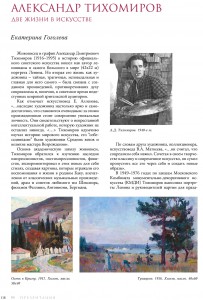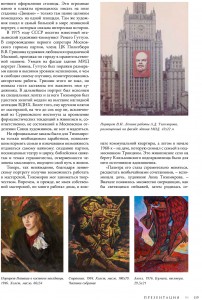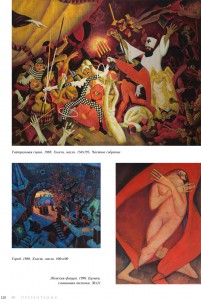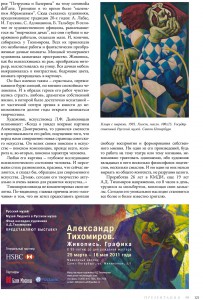Ekaterina Gogoleva
«Russian art» magazine, # 2, 2011
Painter and graphic artist Alexander Dmitrievich Tikhomirov (1916–1995) went down in history as the author of Leniniana and creator of the world’s largest portrait of Lenin (42×22 m). However, his second life as an artist – secret, tragic, confessionary and the main one for him – was devoted to creation of paintings which went against the spirit of social realism and, of course, remained inaccessible for wide audience during the Soviet time.
As noted by the arts expert E. Allenova, «…heritage of the artist is so bright and self-sufficient that it becomes obvious that there is an absolutely unique personality standing behind these works of art. They imply constant intellectual work which the artist never seized doing. Tikhomirov has thouroughly studied the history of the world’s art, his «companions» were Medieval artists and great masters of Renaissance».
Having acquired techniques of academic drawing school, Tikhomirov started scrutinizing heritage of impressionists, post-impressionists and fauvists, experimenting with these new styles, creating pantings which reflected his memories of life in his hometown Baku, impressions from classic musical compositions, dramas and sonnettes of his favourite Shakespear, films of Fellini, Antonioni, Bergman. A.D. Tikhomirov, 1940s.
According to the artist’s friend, art collector and expert V.A. Matveev, «…he believed that social realism has outlived itself. Combining classics and modern art in his works he managed to put it all through himself and create new characters».
In 1949–1976s on commission from the Moscow Conern of Monumental and Decorative Art (KMDI) Tikhomirov was drawing portraits of Lenin and other party leaders for decoration of the capital on occasion of national holidays. These huge panel pictures and posters had to be drawn on the field of «Dinamo» stadium – only there he could fit the panels in one piece. That’s where he has also drawn the world’s biggest Lenin’s portrait, which has an interesting story related to it.
In 1975, famous Italian communist painter Renato Guttuso visited USSR. Accompanied by the First Secretary of the Moscow City Committee of the Party and the member of Politbureau Grishin the artist was enjoying the views of festive Moscow, driving through the city in the governmental car. When he saw Lenin’s portrait on the building of the Ministry of Foreign Affairs, Guttuso was astonished by its size and high quality of performance, which he shared with his companion, having inquired who the author of this portrait is. Grishin didn’t know that, but his guest’s praise made him find out the name of the artist. Later on this portrait was reproduced on special ribbons and Tikhomirov has been awarded with golden medal of the Visual Propaganda Exhibition at the Exhibition of Economic Achievements. Moreover, he was also granted with the keys to his own studio, which he, expelled from Surikov’ Institute for formalistic trends in art, and therefore, not a member of the Moscow branch of the Union of Artists, could not even hope for.
However, official orders have been for Tikhomirov only a source of income, necessary to sustain his family and giving him an opportunity to devote himself to the most important: creation of paintings about the theatre and circus, depicting biblical scenes and touching upon the themes of pilgrimage, rejection of the one who is thinking and looking for his own way in life. Now, having all of a sudden gained opportunity to work in his own workshop thanks to Lenin’s portrait, Tikhomirov could get on with his art. Though, just as he used to when he didn’t have his own workshop, he worked at home a lot, in a room of a communal flat, and during the summer – at the country house which he rented together with the family in suburban Troitskoye. This picturisque village on the shore of Klyazminskoye water reservoir was a source of inspiration for him. «His pallette started changing rapidly, blooming with unusual combinations, – said his daughter, artist Anna Tikhomirova. – First there appeared many glittering, almost glowing landscapes, then came the series «Punch and Ballet Dancer», devoted to commedia dell’arte. In those times Troitskoye was a sort of a «small Abramtsevo». Lots of painters following the traditions of 20s have gathered there: A. Labas, I. Gluskin, S. Adlivankin, B. Talberg. In contrast with official art circles, enjoying themselves at «creative art villages», they all worked obsessively and hard taking very short breaks. And of course they often gathered at Tikhomirov’s place. Everyone was attacted by his unusual works and fantastically transformed rooms of the country house. Powerful temper of the artist filled out the space. His art was splashing out of the paintings, transforming the interior and bursting outside. All furniture was painted into contrasting, refreshing colours, turning the room into a painting». That’s exactly what he was like – passionate, going through a storm of emotions, but seemingly calm person. And it transferred to his characters – one could feel passion, love and drama of his own life, which was challenging enough – starting from partial loss of eyesight and up to lack of opportunities to create his works in the open.
From the memoires of the atrist and arts expert L.F. Dyakonitsyn: «When I saw the paintings of Alexander Dmitrievich, I was surprised by boldness and originality of his works, a feeling of discovery of an absolutely new page of the Soviet art. He is great by his search in art – search of a composition, first of all, of a colour, and secondly – search of a human character. Any of his paintings is a deep research of a psychological state of a person. And his characters are so differently sized and beautiful that now, I would say, they could be taken as an example for the modern art. I think, today his art has a pertinent value and is of high importance for art development…»
Tikhomirov has never commented on his paintings. Apparently, main reason for such «silence» was in his desire to give a spectator freedom to percieve his pictures and make up their own opinion. None of his works, whether devoted to the theatre or on the theme of exile – could be interepreted clearly this or the other way, for the artist has put several philosofic messages, several meanings. And none of them can be taken out of general context without destroying the whole. Having worked for 26 years at KMDI, over another 19 years A.D. Tikhomirov has worked hard behind the easel, sometimes spending there 8 hours a day, putting all of his ideas into reality. Today his unique heritage becomes more and more known to the public.



